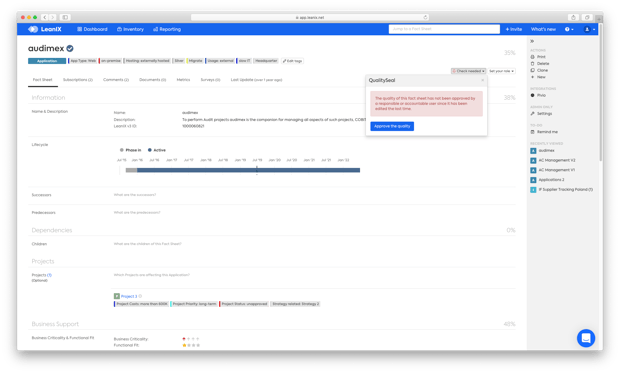
At LeanIX we regularly say that Enterprise Architecture programs are not able to succeed unless championed by the right people. The reason why is simple: all enterprises develop incredibly unique IT networks that can only truly be mapped by those with free access to equally specialized intelligence. And once (or, if) this information is made available, it must be qualified according to a company-based technical criteria before its contributions to the business as a whole can become interpreted within a dedicated system.
But Max Bishop went one step beyond our usual talking point in his 2019 US EA Connect Day presentation on “How to Launch a Successful Roll-Out” by discussing not only how to garner top-level support for budding Enterprise Architecture programs—but also how to sustain them once you do.
Head of Enterprise Modeling for EBSCO Information Services (EIS), one of the world’s busiest premium information portals, Bishop volunteered to share his company’s success story despite them having only begun using the LeanIX Enterprise Architecture Management tool the summer of the year before.
From July 2018 to May 2019, EIS’s efforts to inventory its IT landscape, as conducted and mobilized entirely using LeanIX, transpired at an unprecedented speed—a rate exemplified by the following numbers:
- 1722 IT Components
- 55 Business Capabilities
- 355 Processes
- 162 User groups
- 60 Projects
- 191 Applications
- 696 Interfaces
- 158 Data Objects
- 65 Providers
- 182 Technical Stacks
Collaborative teamwork is how EIS accomplished this feat, but it was precipitated by Bishop’s educating of stakeholders (or, as he referred to it, “socialization”) on why and how LeanIX addresses two common reasons for why Enterprise Architecture programs often fail: (1) stakeholders do not have a platform to disseminate information; and (2) stakeholders no longer trust the quality of data they receive.
So to prepare EIS for life with modern Enterprise Architecture Management, he distributed a company-wide RACI diagram (Responsible, Accountable, Consulted & Informed) and color-coded ToDo’s to outline new responsibilities for all participants. Bishop conducted 22 engagement and learning sessions during this phase, and in particular, he staggered his LeanIX stakeholder and advocacy first on Project Managers and then heavily on Development Teams to gradually assign technical ownerships and uncover the locations of all source codes. The result? EIS eventually adapted its own workflows to include LeanIX as a compulsory quality assurance tool for projects deployed via internal Agile processes.
Said Bishop: “With a lot of socialization over time, the seedlings of our community have been able to grow.”
[For context: A guide to performing standards management with LeanIX]
All in all, LeanIX has so far given Bishop and EIS a platform to manage IT in the precise ways they actually want. But rather than just functioning as a device to help “declare ownership”, he said, the modern Enterprise Architecture Management tool has been able to inspire a “sense of ownership” among stakeholders—a key ingredient in motivating true employee engagement and creating self-sustaining innovation projects.
That being said, let us go through some LeanIX features that help groups like EIS accelerate the growth of their Enterprise Architecture programs:
- Fact Sheet Ownership
- Data Quality Seals
- Customer Success Programs
Keys to Modern EA: "Fact Sheet" Ownership
Today’s best EA breaks down barriers to data exchanges for staff inside and outside of IT organizations. But it also makes data maintenance a collective duty by entrusting all parties to safeguard the accuracy of the information they provide. Together everyone builds an up-to-date application inventory—a single source-of-truth—to guide current and planned architectural transformations.
LeanIX disperses data collection efforts while implementing fail-safe accountability measures. Stakeholders are assigned varying degrees of ownership over the upkeep of “Fact Sheets”—the individual repositories used to document all information regarding architectural objects.
Collaborators are subscribed to Fact Sheets by administrators, or can manually do so themselves, to receive instructions and updates. If the to-be subscribed person is not registered with the Tool, they can be invited without difficulty. Such is the benefit of a browser-based SaaS not structured around a cost-per-user model.
All collaborators are classified primarily by their chief obligation to the Fact Sheet’s maintenance—be it Responsible, Observer, or Accountable—and secondarily by their specific job role in the enterprise.
Responsible:
- If subscribed to a Fact Sheet as “Responsible”, this user is to actively participate in the content creation of the Fact Sheet.
Observer:
- If subscribed as “Observer”, this user is to follow each development of the Fact Sheet.
Accountable:
- If marked as “Accountable”, this is the sole user who must sign-off on a Fact Sheet’s accuracy and completeness.
The Accountable keeps the Responsible(s) in check. The Observer(s) scrutinize the Accountable. And the actions of all three can be inspected by anyone in the user network—all of which to make the principal EA’s surveillance painless and straightforward.
[For context: A way to rationalize applications using LeanIX]
Keys to Modern EA: Data Quality Seals
The LeanIX Quality Seal is a way to prevent Fact Sheets from slipping into irrelevance by automating reminders to those responsible for its maintenance. Quality Seals appear on the top right of a Fact Sheet and will “break” if past their review date. A broken Quality Seal triggers a call to action for those subscribed. It works in conjunction with a Fact Sheet’s “Last Edit Date”, the date/time of the most recent update. Moreover, if someone not responsible for the Fact Sheet changes an element, the quality seal will break and release a notification. Notification mails can be aggregated if required, and all events connected to a Fact Sheet are sent to an audit log.
Keys to Modern EA: Dedicated LeanIX Customer Success Managers
LeanIX is designed to let enterprises of all sizes perform Enterprise Architecture directly upon activation. But to ensure this actually happens, a dedicated Customer Success Manager is paired with every client to provide concrete action plans and recommended best practices for the execution of tailor-made IT/Business strategies. In four weeks, LeanIX promises the following:
Week 1
- Workspace setup (incl. SSO)
- LeanIX support & resources known
- Joint understanding of onboarding goals and expectations
Week 2
- Prioritization of data for initial import
- Mapping of customer data to LeanIX metamodel
- Initial data imported
Week 3
- Analyzable/actionable data and accessible reports
- Well-configured workspaces to welcome pioneers
- User-enablements planned
Week 4
- Setup for sustainable governance
- A LeanIX community
- Agreed upon success KPIs, mid-term goals/roadmaps and mode of interaction
Free Demo
Ben Bishop and EIS represent one of >180 similarly enthusiastic LeanIX customers, and without people like them, our tool would not have achieved the success it has in as short a time. But LeanIX does not create passion for innovation—it simply gives users a platform and communication model to finally express it for themselves.
And if you and your company have the desire to innovate, we will help you deliver. Just let us show you how in a free demo.
“How to Launch a Successful Roll-Out” by Max Bishop




.png?width=140&height=107&name=BTMPlaybook-FI%20(1).png)

